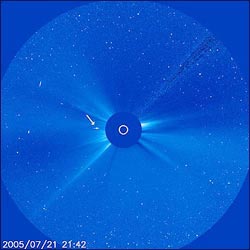SOHO watches Saturn and Cassini pass behind Sun

Saturn seen passing behind the Sun
In this SOHO image, taken 21 July 2005, the Sun is represented by the white circle in the centre. Saturn is the bright object to the left of the Sun.
Saturn was approaching a position called ’superior conjunction’, that is, it would be almost directly behind the Sun as seen from Earth. Therefore the NASA/ESA/ASI Cassini spacecraft, in orbit around Saturn, was not able to send or receive transmissions normally.
As Cassini passed close by the limb (edge) of the Sun on 24 July, communications became impossible because of the Sun’s radio noise. The spacecraft regained full communication with Earth on 27 July, once again returning Saturn science data.
In the meantime, Cassini radio scientists are taking advantage of this opportunity to study the Sun’s corona from its effects on the radio signals that reach Earth. This is a joint co-ordinated observation involving two SOHO instruments (UVCS and LASCO), plus Cassini and some ground-based radio sites.
Interestingly, the bright ’streak’ accompanying Saturn is not the rings but a result of ’pixel bleeding’.
SOHO, the ESA/NASA Solar and Heliospheric Observatory, orbits the Sun parked in one of the five gravitationally neutral spots, called ’Lagrange points’. This specific spot, called L1, stays in the same place relative to the Sun and Earth, offering SOHO a continuously uninterrupted view of the Sun.
Media Contact
More Information:
http://www.esa.int/esaSC/SEM3IE808BE_index_0.htmlAll latest news from the category: Physics and Astronomy
This area deals with the fundamental laws and building blocks of nature and how they interact, the properties and the behavior of matter, and research into space and time and their structures.
innovations-report provides in-depth reports and articles on subjects such as astrophysics, laser technologies, nuclear, quantum, particle and solid-state physics, nanotechnologies, planetary research and findings (Mars, Venus) and developments related to the Hubble Telescope.
Newest articles

Superradiant atoms could push the boundaries of how precisely time can be measured
Superradiant atoms can help us measure time more precisely than ever. In a new study, researchers from the University of Copenhagen present a new method for measuring the time interval,…

Ion thermoelectric conversion devices for near room temperature
The electrode sheet of the thermoelectric device consists of ionic hydrogel, which is sandwiched between the electrodes to form, and the Prussian blue on the electrode undergoes a redox reaction…

Zap Energy achieves 37-million-degree temperatures in a compact device
New publication reports record electron temperatures for a small-scale, sheared-flow-stabilized Z-pinch fusion device. In the nine decades since humans first produced fusion reactions, only a few fusion technologies have demonstrated…





















